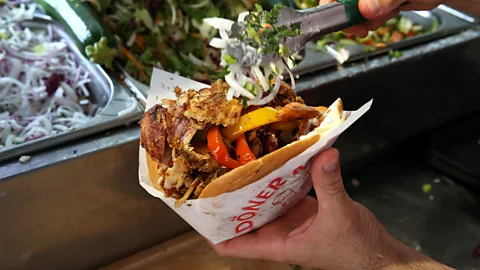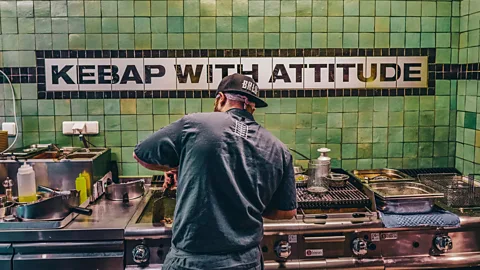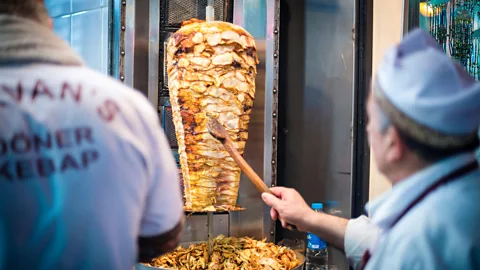 Alamy
AlamyWith the Turkish government asking to have the döner kebab recognised as a Turkish specialty, everyone’s favourite late-night snack is the big topic of discussion in Germany right now.
If there’s one thing that unites Berliners, it’s an appetite for the döner kebab. Office workers in search of a quick lunch, children on their way home from school, late-night revellers weaving their way between venues – all of them stop in regularly at one of the city’s many döner kebab shops.
What lures hungry Berliners is spice-rubbed beef cooked on a vertical spit, thinly sliced and piled into pita bread with crunchy salad, often slathered with garlic-laced yoghurt sauce. It’s a German take on the traditional Turkish döner kebab – the same meat served on a plate with rice and salad.
Yet, if the Turkish government has its way, every single döner shop in Germany – more than 1,000 of them in Berlin alone, according to Visit Berlin – may soon be banned from selling döner kebabs under that name.
In a recent application to the European Commission, the Turkish government asked to have the döner kebab recognised as a Turkish specialty, one that was born and developed in what is today Turkey. That would give it the same status as Italy’s Neapolitan pizza or Spain’s Serrano ham. Only kebabs adhering to strict criteria could be called döner kebabs – and Berlin’s more portable version would not pass the test.
Germany’s Federal Ministry of Food and Agriculture (BMIL) was one of 11 organisations to lodge an objection. “We have taken note of the application from Turkey with some astonishment,” a spokesperson said in a statement to BBC.
 Getty Images
Getty Images“The döner kebab is part of Germany, and the diversity of its preparation methods reflects the diversity of our country – this must be preserved,” the statement continued. “In the interests of the many fans in Germany, we are committed to ensuring that the döner kebab can remain as it is prepared and eaten here.”
The Berlin version of the döner, which has since been embraced around Germany, was born in the early 1970s, according to Visit Berlin. Two separate men lay claim to its creation. Mehmet Aygün and Kadir Nurman were both part of the wave of Turkish “guest workers” who helped fuel Germany’s post-war economic boom. They took the classic Turkish döner kebab and turned it into an easy-to-eat sandwich that is now an economic force in its own right.
The humble döner is estimated to generate annual sales of roughly €2.3bn in Germany alone, and €3.5bn across Europe, according to the Berlin-based Association of Turkish Döner Producers in Europe. Its accessible price point has made it a tool for political point-scoring: earlier this year German left-wing party Die Linke demanded the government introduce a Dönerpreisbremse, or döner price cap. (The government declined.)
The elevation of this humble sandwich into a daily staple was a remarkable achievement by a generation of Turkish men, according to Deniz Buchholz. “Nothing was written down; their recipes were passed from mouth to mouth. Society placed no value on what they did but they did what they did with conviction.”
 Kebap With Attitude
Kebap With AttitudeBuchholz is the half-German, half-Turkish co-owner of Berlin’s Kebap with Attitude, a restaurant that takes a more contemporary approach to the dish, introducing the sort of modern flavours to the döner that are now standard for pizzas and burgers.
Selections include Funky Mango, made with chicken, mango-cranberry chutney and sesame-coriander pesto; Vallah Vegan, made with plant-based meat, cauliflower and pomegranate; and a Truffle Delüks with beef, green asparagus, roast potatoes and grated truffle.
None of these would be allowed under the Turkish proposal, which regulates everything down to the width of each slice of meat (between 3-5mm thick). Beef would have to come from cattle that is at least 16 months old and be marinated with specific amounts of animal fat, yoghurt or milk, onion, salt and thyme, as well as black, red and white peppers.
Not everyone believes in a strictly defined döner, however. Culinary historian Mary Işın, who has written extensively about the history of Turkish cuisine, says she has seen the döner evolve during the decades she has lived in Turkey. For a start, she says, the beef döners served up across Turkey today, are a recent innovation.
“I was here in the ’70s and döner was always made with lamb,” Işın says. “I don’t know how this happened, but they seem to have persuaded people that lamb is greasy and bad for you. Many people here won’t touch lamb anymore – they only eat beef.
“And if I’m remembering correctly, you just had some sliced onions with it. You wouldn’t have tomatoes and peppers like they force on you today.”
 Alamy
AlamyIşın researched the kebab’s history in a paper titled Ottoman Kebab Culture and the Rise of the Döner Kebab. “It’s a history with many huge gaps,” Işın says, noting that the phrase “döner kebab” doesn’t appear in a written Ottoman source until 1908, although the earliest depictions of döner kebab roasting on a horizontal spit date to the 17th Century, in two miniature paintings in a Turkish translation of the epic Persian poem, the Shahnama.
“There’s very, very little about it, but we know it must have been there, because all of a sudden in the 19th Century, you have foreign tourists coming in and talking about döner kebab. It’s as if it was so ubiquitous that no-one [local] saw the point of talking about it.”
Ottoman cuisine traditionally included a range of kebabs, or roast meats, including small pieces of mutton served on a skewer (şiş kebabı) and oven-roasted meat (tandır kebabı). Döner kebab, discs of meat grilled on a rotating skewer (the name comes from the verb “dönmek“, meaning “to turn”), was originally an outdoor food, popular at picnics.
One clue as to how it evolved comes from a 1433 account by Bertrandon de la Broquiere, a French traveller. He describes meeting a group of Turkish travellers in Anatolia who invited him to share their spit-roast sheep.
“Instead of waiting for the whole sheep to cook through, they are cutting slices off the outside, which, of course, makes a lot of sense – you’re not going to wait for four hours before a whole sheep is cooked, right?” Işın says. “The horizontal spit becomes vertical later when they open kebab houses, where a vertical spit takes up less space.”
The European Commission has directed the Turkish and German governments to engage in talks to find a compromise, but the ramifications of any agreement are likely to be felt right around the world, where döner has become one of Turkey’s most popular exports.
 Getty Images
Getty Images“After school I would watch my mum and dad prepare the ingredients at home: mixing the spices with the mince mixture, layering the layers of mince with thin layers of topside steak. My father used to say the steak holds it all together. He would wrap it tightly and carry it to the fridge – and that thing used to weigh 50kg.”
The kebabs the family served up were similar to the classic Berlin recipes, with pita bread stuffed with tomato, lettuce and onions as well as the meat. A choice of sauces was available, including yoghurt sauce.
“The mince was blended with onion and red capsicum, and then there was paprika, black pepper, salt, maybe a little cumin,” Gani remembers. “Turkish cuisine doesn’t overpower food with too many spices and sauces. It is about letting the hero ingredient stand out.”
Gani says that kebabs are not the only Turkish dish that have sent culinary echoes across the globe. “We make cabbage rolls called sarma – which means “rolled” – that they also make in Ukraine and Bulgaria,” she says. “We have stuffed grapevine leaves that we call dolma – which means “stuffed” – that the Greeks call dolmades.
“Ultimately, food is something we all have in common. Everyone bonds over food.”
Food Wars is a series from BBC Travel that invites you to feel the heat when passions flare around beloved dishes that shape a culture’s identity.

